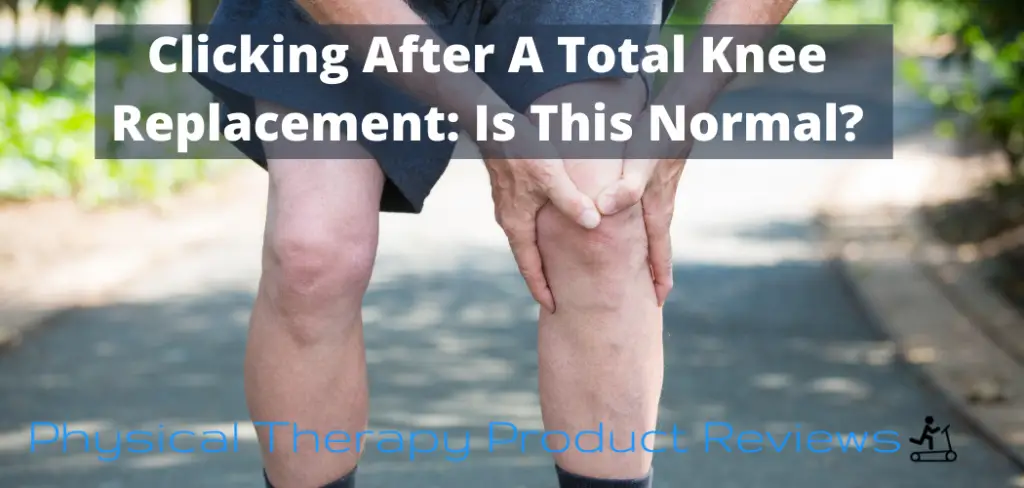 Many patients post-total knee replacement will experience clicking or popping in the knee. This is typically a normal part of the healing process and should not be cause for alarm.
Many patients post-total knee replacement will experience clicking or popping in the knee. This is typically a normal part of the healing process and should not be cause for alarm.
The clicking may happen when you bend and straighten your knee, but it may also occur without any movement at all and are just standing on the knee.
So when is the clicking in the knee a concern? We’ll review the instances that clicking in the knee is normal and when you should start to do something more about it.
Is Clicking Normal After a Total Knee Replacement?
Yes, most instances of clicking are normal after a total knee replacement.
There are a few different potential causes that we’ll review but the vast majority of reasons are normal and expected. Some potential causes are:
- the prosthetic clicking during normal knee movement
- scar tissue that is remodeling
- swelling in the knee causing normal pressure changes within the joint
- In rare instances the prosthesis will make noise if it is coming loose but we will review what this looks like
What Causes Clicking in a Knee Replacement?
The most common cause of clicking is from normal movement in the replacement knee joint that produces noise from contact from the ends of the prosthesis.
The clicking is most likely to occur when you bend and straighten your knee joint. It typically is not painful but can be annoying to some people.
Some patients will even have this normal clicking every time that they swing their leg with walking. This is more of an annoyance than anything as this can be a normal symptom.
Is Clicking After a Knee Replacement Scar Tissue?
The clicking could be caused by scar tissue that is in the process of remodeling. Scar\r tissue formation is normal after surgery and this resulting fibrous mass may come in contact with muscle and tendons that are moving, producing clicking noises.
As the scar tissue heals and remodels over time, it will become smaller in size and more flexible. This should reduce the amount of clicking in the knee after surgery.

Is Movement in the Knee Joint Normal After a Knee Replacement?
The clicking noise is usually more pronounced with movement. This is because the clicking can be caused by the prosthesis itself. Some people become concerned or alarmed because they can feel more movement in the knee joint than before surgery.
For example, people after a knee replacement can lift their leg in the air and shake it side to side and feel clicking and movement. This is a normal movement for a total knee prosthesis.
Where is the Clicking Coming From after a Knee Replacement?
Most of the clicking will come from one of two places, behind the knee cap and the joint line where the knee prosthesis is.
The clicking behind the knee cap is the new high-grade plastic resurfacing that is a bit more noisy than bone during normal movements. This is normal.
The click near the joint line is the prosthesis keeping your knee in place. The prosthesis is designed to provide stability forward and backward and side-to-side by being deeper than your original knee joint. The clicking can be the prosthesis reaching the end of the designed movement and stopping the knee from going further.
When Should I Be Concerned About Clicking With a Total Knee Replacement?
In very rare instances, the clicking noise can be a sign of loosening in your prosthesis. If you are experiencing clicking that is painful or is accompanied by a large change in swelling around the knee joint, then this could be an indication for more investigation as these symptoms may indicate loosening.

Other signs of abnormal clicking are clicking with a giving away in the knee, or a clicking and the feeling that your knee is going to fall off, especially when you are swinging the leg during normal walking.
Telling the difference between normal clicking and an issue with looseness will require additional imaging such as MRI.
Signs of Abnormal Clicking After a Knee Replacement
Here are few things that may indicate abnormal clicking in the knee and should be brought to your doctor’s attention:
- Clicking with the knee giving out, especially if this happens often.
- Clicking followed by a sharp pain, especially when you put weight on the leg.
- Clicking with a noticeable change in swelling after the click
- Clicking with a feeling of the knee locking or getting stuck
Tips to Reduce Clicking in a Total Knee Replacement?
For normal clicking after a knee replacement there are a few simple things that you can do to reduce the frequency and the intensity of the clicking. Normal clicking does not indicate damage or that anything is wrong with the replacement, it is simply an annoyance to the person who just had surgery.
Strengthen the Quad
The quad controls ~60% of the function of the knee. The stronger the quad muscle gets the less clicking and annoying rubbing you might have.
Wear a Compression Sleeve
A compression sleeve can help by providing more stability in the knee joint and help with alignment of the knee cap, especially in the early stages of recovery when the muscles aren’t fully strong yet.
Try Taping It
Sometimes something as simple trying a little bit kinesiotape across the knee joint or around the knee cap is enough to reduce the clicking. The tape can also add a little support similar to compression sleeve.
Anti-inflammatory medications can help reduce clicking
Using NSAIDS in certain situations can help clicking but it’s not our favorite long term solution. If the clicking is caused by a increase in swelling a short trial of anti-inflammatories can be successful.
Conclusion
The clicking that some people experience after a total knee replacement is normal. The clicking can come from both the end of the prosthesis and behind your knee cap, which are designed to provide stability as well as movement in different directions.
If you are experiencing clicking and would like to reduce the frequency there are a few simple things that can help including strengthening your quad, wearing a compression sleeve, using kinesiotape and anti-inflammatory medications. Painful clicking and the sensation of the knee giving away should be evaluated further.
Other Great Rehab Related Articles
GLP Weight Loss and Back Health: Effective Strategies and Insights
How to Stay Active After Cervical Fractures: Expert Tips and Advice
Dealing with Painful Stairs After Ankle Replacement Surgery
Walking After a Total Ankle Replacement: Tips for a Successful Recovery
Exercises While Non-Weight Bearing After Ankle Replacement: Elevation, AROM, Leg Raises, and More
Ankle Pain with Stairs: Causes and Home Treatment Options
Disclaimer: The information provided in this post is for educational purposes only. This is not a substitute for a medical appointment. Please refer to your physician before starting any exercise program.







